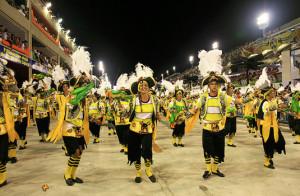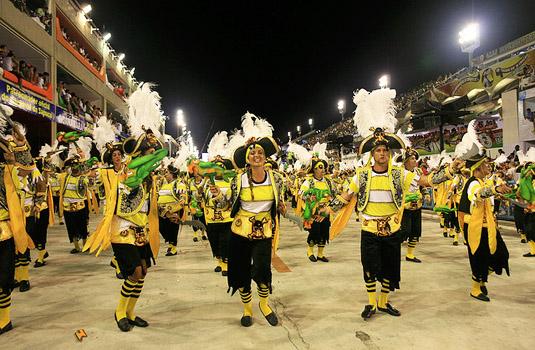
A samba class performs in Rio de Janeiro.
There’s an expression here in Brazil: “Tudo acaba em samba.” Translated literally, the phrase means “Everything ends in samba.” That is to say, no matter what disagreements, differences or tensions may exist between two people, at the end of the day, they unwind the same way — dancing it out in close proximity at the local samba hall.
It’s simple, romanticized and fits neatly with the cliche that everything about Brazilian culture revolves around soccer, Carnival and samba — the popular Brazilian music genre and dance. Obviously, the literal extent of this concept is limited and has a lot to do with the myth of “racial democracy” in the country — the mistaken belief that racism doesn’t exist here. Nevertheless, there’s a reason that the saying has become a colloquial favorite and there is undeniable truth to the notion that dance can bring people together in a way that nothing else can.
July 10, 2014, was the day that I learned to dance. I didn’t think it could be done, but it happened. I have no sense of rhythm or hand-eye coordination and frankly, the thought of any type of dancing gives me anxiety. I’m notoriously clumsy when it comes to everyday tasks but add some complicated turns and predetermined steps to the mix and I’m a goner. I have long since given up and accepted that dancing would just never be my forte.
However, it’s hard to avoid in Brazil, where everything from dating to socializing to my daily classes revolves around the country’s rich tradition of music and dance. Two weekends ago, I took a short trip to Ilha Grande with a few friends from my program and we quickly discovered that the nightlife in the small village we were staying in consisted exclusively of a live band in the praça — the town square. Everybody just hung out and danced forró. Cue the panic attack. My first partner actually gave up on me. “Follow, follow,” he implored desperately as I stepped on his foot for the third time. “One, two. One, two. No matter what I do, it’s one two.” Like so many times before, dancing and I simply did not work out.
However, this tragic pattern of try and fail finally came to an end last week, on that fateful date. One of the activities that our school scheduled for us here in Rio was a three hour samba and forró class. I was willing, but not hopeful and showed up with the goal of just learning the basics.
After a clumsy warm-up, I got paired with the only member of the group who was not a university student, a 55 year-old, well-meaning but awkward professor. But that’s not all. Brazilian dances are ridiculously sensual. As we nervously laughed and avoided eye contact throughout the entire debacle, I prayed silently for it to come to a hasty end. Thankfully, it did. He had to leave early and I was left without a partner, perfectly content to just watch the rest of the lesson from afar.
After a song or two though, the instructor realized that I was alone and took it upon himself to fill the role. I’ll never understand how he could move like that. He was an unbelievably talented dancer, and for the first time in my life I understood what he meant when he told us to stop thinking, listen to your partner’s body and just follow along. We said nothing besides an exchange of names and a compliment or two, yet somehow, I was dancing. I followed his lead and the two of us served as the example that the rest of the class followed. It was almost effortless.
I didn’t want to stop. Later that night, a group of us headed to Lapa, the place to be in Rio for authentic Brazilian nightlife. At the dance hall we went to, one guy and I danced together the entire night. I don’t know what dances we danced to or when I learned to dance them, but dance we did. I stepped and twirled and spun and dipped. At regular intervals, we were the couple that people walking in pointed to as an example of how to execute different steps.
In conclusion, dancing is possible. Like many things in life, you just need a good partner.
Dance is so special because it transcends language barriers and cultural incompatibilities. Movement, music and closeness are universal concepts. Dance can be a way to make a brief connection with someone you cannot otherwise communicate with and may never see again. All over the world, people go dancing to let loose, meet someone special or just spend some quality time with friends. “Tudo acaba em samba.”
Allison Hillsbery is a rising sophomore in the McDonough School of Business. Ready for Rioappears every other Monday at thehoya.com.














